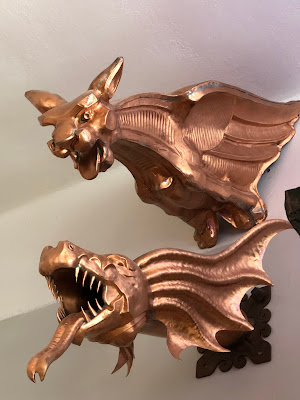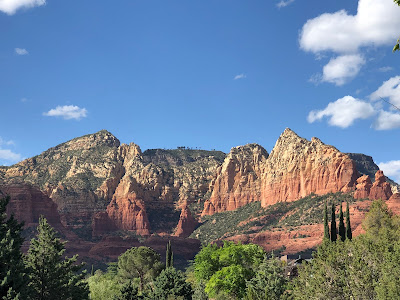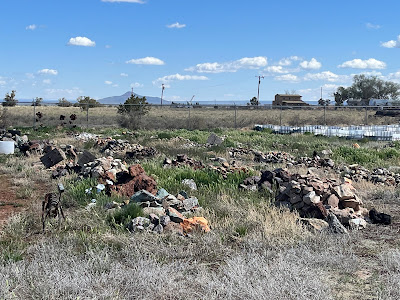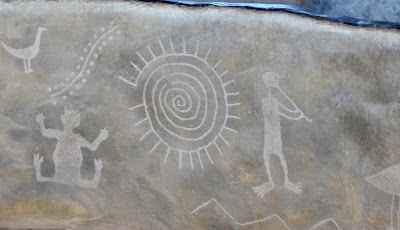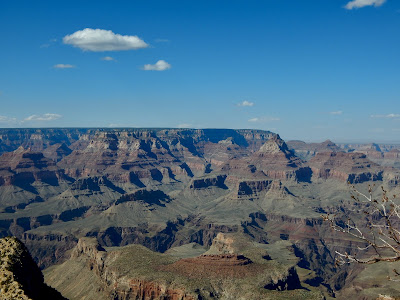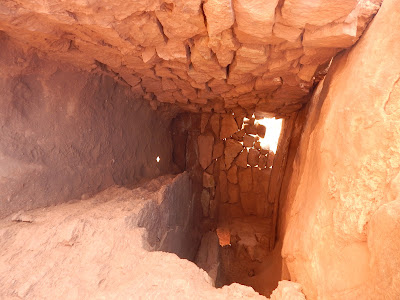It is our last day in Arizona, we leave tomorrow to We headed back to the Verde Valley today to check out the town of Jerome. Jerome is a city that was founded in 1899 when to ore bodies of copper was discovered. It is located up on at hillside over 5000 feet above the valley.
This is looking from Jerome back down at the Verde Valley.
United Verde Mine developed by William Clark and United Verde Extension Mine, owned by James Douglas extracted copper, gold, silver and other metals from two main veins of over 1 billion dollars until 1953 when the deposits ran out.
This is the old mine site at the top of the hill

At one time there was more than 15,000 people living in Jerome but when the mines shut down, Jerome virtually became a ghost town with only 400 people remaining. The remaining residents created the Jerome Historical Society and opened the Jerome Mine Museum. They started the Ghost Town business, taking advance of the media descriptions of being declared dead. Ghost town signs were placed on both ends of town describing how Jerome once boasted a population of 15,000 with each declining number crossed out, leaving only the term “Ghost Town” As time rolled on restoration of the building progressed rapidly. In 1979 the media headlined a story: A Ghost Town Comes Back To Life and yesterdays Hippies share in credit: Hippies were credited for rebuilding old houses, starting new business and revitalizing town services. There are many high end shops with art galleries and artisans. There are number of restaurants and coffee shops, the Haunted Burger is known throughout the valley. There are also a number of historical buildings that have been restored such as the Hotel and Saloon.



From Jerome we headed back down the hill to Clarkdale, which was the site of the smelter for the copper mines. The town was named after William Clark who built the town for the copper industry. It was Americas first company town for 7,000 people and was built for one million dollars. After the copper mine shut down the town declined to 900 people but now has turned into a retirement town. It is also home to the Arizona Copper Art Museum. In 1958 the Meinkes of Minnesota started a collection of copper molds and cookware. Over the years their collection grew to such size and prominence that the family envisioned sharing their acquisitions with the public, their son Drake joined his collection with his parents and in 2000 started looking for the perfect site. Since the nickname of Arizona is the Copper State and the largest copper producer in the nation and Clarkdale having the most profound copper connection in the country was chosen.
The old high school in Clarkdale was chosen and it is a nice mix of history of the town and an amazing collection of copper art and functional items.
A wash basin
This is described as Trench Art. Soldiers during the WWI & WWII would take the artillery shell casings that are made of brass, an alloy of copper and zinc. The expended casings were transformed into art by the soldiers in the trenches hence the name.
These are a few of the gargoyles
Copper has been used in many cooking vessels and is prized by many chefs as it distributes heat evenly, cooks quickly, saves on energy, retains heat. It does however need and tin lining to stop heavy metal poisoning.
This is a distillery and has been used for wine, beer and spirits. Copper is also know for its disinfecting properties. It is used on door knobs, railing and other objects that are touched frequently by the human hand. A door knob that is tested initially with 10 million bacteria after 90 minutes has only .1 million bacteria vs plastic knob has 10 million bacteria to start and still has 10 million bacteria 90 minutes later.
After Clarkdale we headed north back to Sedona and spend the afternoon in their downtown area browsing the shops and admiring the art work.
These Javelina statues are around the town, they are wild pigs that roam the area. They are very cute. Unfortunately we never did see any live ones, I had to be content with the statues.
There are a large number of shops all along the edges of the highway and they two stories of art galleries, restaurants and lots of crystal shops. The restaurants all have very beautiful views of the red rocks around them.
This is a statue in a gallery that I managed to sneak a picture of. This artist did these amazing sculptures of animals in traditional native attire. This is a spirit bear.
Another view from a pub.
This is a metal statue of a stag at the Indian Gardens Store in the valley between Sedona and Flagstaff
We are now getting all our laundry done and everything packed into the truck as we are leaving early tomorrow to start the journey home.







